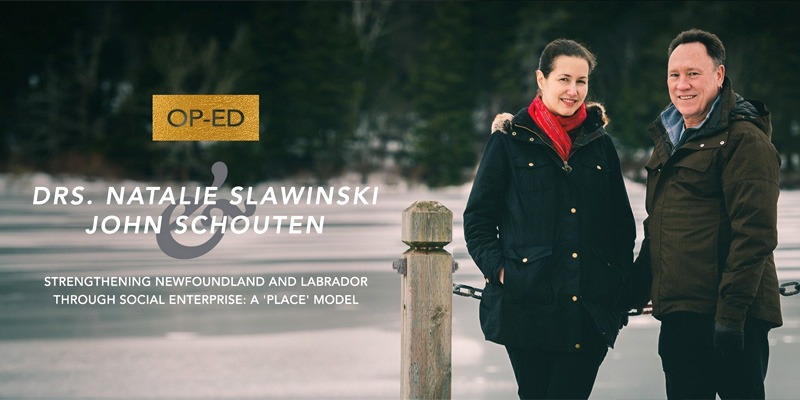OP-ED Drs. Natalie Slawinski and John Schouten

As strangers driving into Norris Point, N.L. on a wintry January morning, we get an impression of both sleepiness and industry.
The tracks from the previous car are being whisked away by a broom of wind and snow. A bearded man piloting a snow blower raises a hand of greeting as we pass.
Not much else is happening but pride and activity are evident. We see it in the tidiness of the houses, in the neatly stacked firewood, in the shovelled walks. C&J Rumbolt’s general store is open for business with everything from homemade jams to beer and cigarettes to winter coats.
The coats, stacked in a cardboard box, are $50. The conversation is free.
We have come to this village surrounded by Gros Morne National Park to meet with a group of local community champions dedicated to the social, economic and environmental well-being of Western Newfoundland.
The topic of discussion is a “PLACE Model of Community Development,” derived from seven years of research on Fogo Island by a Memorial University-based team in partnership with Shorefast.
Our meeting in the old Bonne Bay Cottage Hospital — now repurposed into a social enterprise hosting a hostel, health retreat and community centre — is fuelled by homemade chili, cornbread muffins and a passion for Western Newfoundland.
As we present our model, the discussion is lively and studded with personal stories. The acronym PLACE signifies five principles for community development that emerged from our research.
It also evokes the primary condition for rural renewal: a deep and abiding love of place. Each step in the model elicits recognition and personal stories from the people around the table.
The steps, which are interrelated and iterative, are as follows:
P = Promote community champions
L = Link insiders and outsiders
A = Assess local capacities
C = Convey compelling narratives
E = Engage both/and thinking
Promote community champions
Community champions advocate for the community and work tirelessly to improve it.
They have “an unwavering faith in a path forward,” as Shorefast chief financial officer Diane Hodgins explains. As they work on initiatives to better the community, they need to identify and promote other community champions.
Link insiders and outsiders
Insiders, including local volunteers, municipal government representatives, business owners and other residents, possess deep knowledge about a place.
Outsiders, such as visiting artists, industry experts, media and academics, bring new skills and perspectives, often helping insiders to see their community with fresh eyes.
New opportunities for community renewal can emerge when insiders and outsiders work together.
Assess local capacities
It’s easy to take local treasures for granted when you have lived with them your whole life.
Outsiders can help insiders to better appreciate what they have. Insiders can also take stock of their community’s unique assets by asking, “What do we have? What do we love? What do we miss?”
Answering these questions thoughtfully can reveal underused capacities in people, institutions, buildings, equipment and the natural environment, inviting people to explore new opportunities.
Convey compelling narratives
Communities facing long-term challenges can develop self-defeating narratives.
Successful community development depends on finding and sharing positive stories about the place and its people. Positive narratives instill hope.
The right stories can reframe challenges as opportunities, shift mindsets from scarcity to abundance, and remind us how people have overcome challenges in the past.
Compelling stories change behaviours and motivate people to take risks and do the hard work of building something new.
Engage both/and thinking
Community development work is full contradiction and conflict.
Tensions emerge between the old and the new, between tradition and innovation, between the community’s past and its imagined future, between supporting local businesses and benefitting from global markets.
It’s tempting to see such opposing forces as either/or propositions with winners and losers. Successful community renewal depends on both/and solutions. Both/and thinking requires us to embrace ambiguity, to forge common ground and understand differing perspectives, and to keep tough conversations going until a better, third path emerges.
The third path often results in a social enterprise, like the Bonne Bay Cottage Hospital, which provides goods and services in order to support a mission of community development.
It is through commitment to place, and the principles of PLACE, that champions muster the energy, creativity and other resources to renew a community’s economy and sense of purpose.
Our model highlights the importance of community champions gathering to share ideas so that they can continue to leverage a social enterprise mindset. With this mindset, they harness the tools of business in a way that makes their communities, and indeed the whole province, stronger.
The Memorial University-based team members, in partnership with Shorefast, are Dr. Natalie Slawinski, Dr. Blair Winsor, Dr. Mark Stoddart, and Dr. John Schouten, Memorial University; Dr. Wendy Smith, University of Delaware; and Diane Hodgins, Shorefast.
Dr. John Schouten is a Canada Research Chair (Tier 1) in social enterprise and a professor of entrepreneurship and marketing in the Faculty of Business Administration at Memorial. He can be reached at jwschouten@mun.ca.
Dr. Natalie Slawinski is associate professor of strategic management, Faculty of Business Administration, and research fellow, Cambridge Centre for Social Innovation, University of Cambridge. She can be reached at nslawinski@mun.ca.